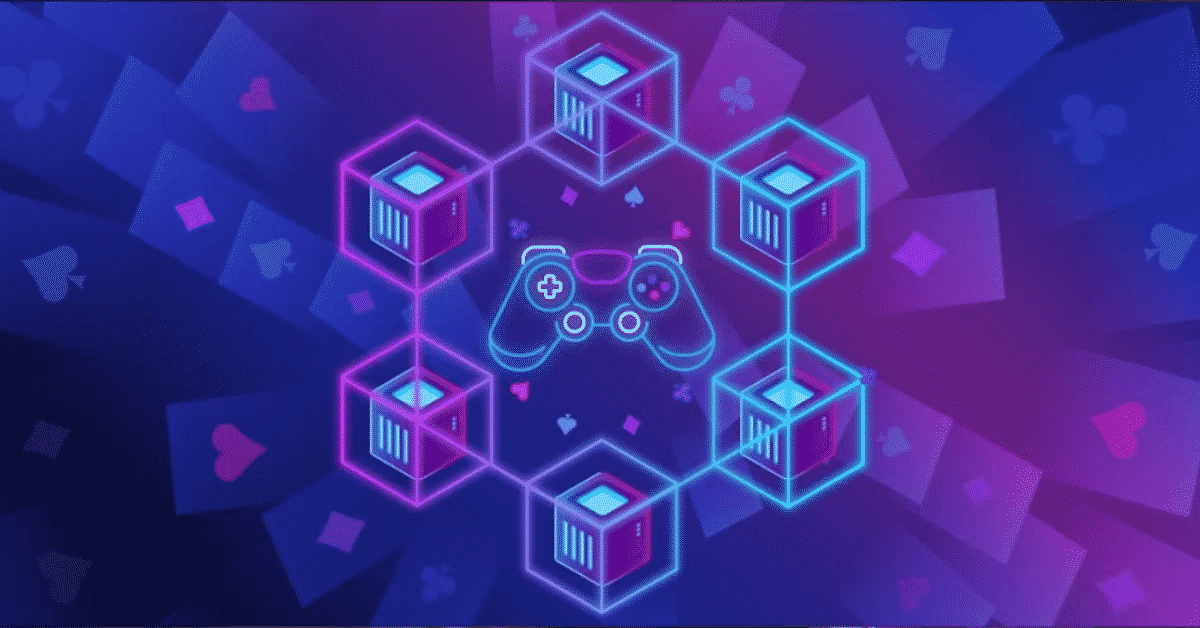If you are passionate about video games and gaming trends, you definitely already know of play-to-earn (P2E) games by now. P2E games gained massive popularity in the second half of 2021 with the rise of Axie Infinity. As the P2E’s name suggests, making money is the primary incentive for players, and with COVID-19 battering the global economy with lockdowns, earnings from playing games attracted an enormous number of players, particularly those living in developing countries. For many players, earnings from playing P2E games not only replaced their lost wages but surpassed regular wages.

To understand the draw and emergence of P2E games, we should look at the business model, the core mechanics of P2E games, and the blockchain technology enabling the P2E innovation.
But to gain dominance and mainstream acceptance, P2E games will have to compete with more fun and engaging gameplays.
The P2E business model
Blockchain technology brought a number of innovations, one of which is the ability to own and trade in-game digital assets. Digital assets, defined here are crypto tokens, both fungible (e.g. cryptocurrency) and non-fungible (unique individually). The cryptocurrency is used as in-game currency, and the non-fungible tokens, or NFTs, represent a unique in-game items such as cards, playable avatars, skins, pets, weapons, or armors.
Players generally earn:
- Cryptocurrency, as a reward for actions within the gameplay. The action can be completing a mission (player-vs-environment or PvE) or winning against another player (player-vs-player or PvP). Nearly all P2E games create their own in-game cryptocurrency (e.g. SLP for Axie) and pay them out as earnings. Games that payout Bitcoin (or Ether) are quite rare.
- Collecting in-game items as NFTs is part of the gameplay. P2E games generally don’t directly payout NFTs, but the game mechanics allow players to obtain rarer NFTs, often through mechanisms such as breeding, evolving, etc. Essentially, through a pre-defined formula of chance and payment, players can convert their NFTs into rarer forms that can fetch higher values at the marketplaces.
Players, or any token holders, can bring their in-game cryptocurrency to exchanges such as Binance to convert back to fiat currencies. For some, they may need to go through decentralized exchanges (DEXs) to swap them for a more popular cryptocurrency such as ETH or stable coins such as USDC before converting back to their local fiat currency through the exchanges.
The game developers earn from both the fungible and non-fungible tokens used in the game. Below is a breakdown of their revenue streams:
- Selling game cryptocurrency — This practice, while prohibited in a number of countries, is quite common for P2E game developers to get bootstrapped. In this initial offering, the game cryptocurrency is created and sold to the backers. This initial funding helps getting the project started, with a large portion dedicated for game rewards. The attractiveness of the game cryptocurrency lies in the potential increase in value of the token when the game gains popularity. Many P2E projects publish their white paper with tokenomics during the offering to attract backers.
- Selling NFTs — Whether genesis or seasonal, selling NFTs to players brings in another round of funds, whether the game is already available or still under development. This funding round can be a lifeline to games that require more extensive development.
- Marketplace commission — Allowing players to trade NFTs with each other is a key element of the game, not only just a revenue stream for developers. Players (and even speculators) expect their NFT investment to rise in value over time, and the marketplace is also a vehicle for players to convert their NFTs into earnings.
- Token valuation — Without a doubt, a rise in token valuation benefits all players, game developers, and game backers (or investors).
This model works well. Game developers are funded to innovate with lower risks, players can earn and are engaged, and investors/backers also earn on the token appreciation. Everyone makes money, but who really pay for these gains?
As it turns out, new players must purchase an initial set of NFTs and/or cryptocurrency to get started. As more players enter the game economy, existing NFTs and cryptocurrency increase in value, forcing newer players to pay higher entry price. Over time, this process visually resembles a shape of a pyramid.
Is the P2E model sustainable?
For any games, players have to spend, whether buying the entire game upfront, in-game items, season pass to unlock content, or the combination of all of the above. If the game doesn’t require paying upfront such as freemium games, a.k.a. free-to-play games, those who pay for the in-game items or season passes provide the revenue stream supporting those who play for free.
Nearly all P2E games require players to purchase a set of NFTs just to start playing, making them similar to paying for the game upfront but with a difference — players own those NFTs. For some games, the NFT upfront cost can be as expensive as a few hundred US dollars, much more expensive than the cost of buying a AAA title on a console. P2E players, thus, have to believe that the earnings from the game brings income beyond the initial investment.
The initial investment can be too substantial for those coming from the developing countries, creating a need of a rental system, in which the players supply the labor (playing the game), and the investors supply the capital (the starting NFTs). Collectively, this structure is called guild, where P2E players spend their time farming in P2E games using the NFTs supplied by the guild. The earnings are subsequently shared between the player and the NFT owner. Larger guilds can obtain better scale by acquiring NFTs at discount directly from the game developer in exchange for bringing in the initial players the guild has. In other words, the NFT discount is exchanged for the initial marketing for the P2E games.
The guild and rental structure works well to reduce the risk and barrier-of-entry for ordinary players, but earning is still very much dependent on both the value of the cryptocurrency and the game NFTs. As long as the market value of the cryptocurrency and NFT rise, everyone can still earn, and P2E games can retain players, and the guild can retain its members. With the recent decline in crypto prices, at times 80% off from peak, the economics of P2E is brought into question. When players don’t earn in a game, they can quickly abandon the game. Similarly, the guild system has to maintain a portfolio of P2E games to quickly shift their resources to the games that generate higher or stable returns.
In effect, P2E games are less of an entertainment but more of a financial or investment venue. For players, playing P2E games has become work and a mundane grind.
The longevity of the game heavily depends on the gameplay, not only how engaging it is for players of different levels but also the balance of the game economy. Experienced (and non-crypto) game developers are already familiar in designing core game loops with high engagement and a sustainable game economy. Game economy management is practically about managing inflation and deflation of in-game currencies (cryptocurrency) and in-game items (NFTs), and in effect, is a matter of managing supply and demand — by controlling the sources and sinks of the resources.
The wild price volatility of the in-game currency and NFTs create a bigger complexity in managing the game economy and player’s behaviors compared to non-P2E games. When the market value of the in-game currency appreciates too quickly, players are more incentivized to hold than to spend within the game. And without adequate sinks of the in-game currency, the market price can drop, reducing the earning potential for P2E players, which may cause player attrition and reducing the inflow of new players.
If the primary motivation to play is to make money, P2E players only stick around as long as the earnings pay more than their regular jobs.
Games must be engaging, not a financial investment
While there is definitely value in earning from games, it shouldn’t be the primary purpose of games. Playing games has always been and will always be about one thing — entertainment. Earning from playing games should only be one of the engaging, but secondary, factors of the game. To gain wider adoption in the mainstream, P2E games must evolve and deliver higher entertainment value while retaining their key attraction — ownership and earnings.
As games become 100% online and digital, what has been missing is the actual ownership of the physical game. For those who are old enough to have played the classic Atari or Sega games, owning the game came with the sense of pride. Even today, some of the classic console games gained collectible values. As games became digital, such ownership no longer exists, and when the player leaves the game or the game shuts down, all values are lost.
Blockchain technology brings an opportunity to enable ownership in the games, and if done right, the ownership can last even beyond the end-of-life of the game. P2E games are early adopters of NFTs to bring ownership to games, and the early movers have captured both the excitement and the economics of this model. At the start of 2022, we are witnessing a proliferation of many newer P2E games vying for attention. The newer P2E games must expand the audience beyond just the crypto-earning enthusiasts who are willing to invest. The gaming audience is vast, and most of them demand higher entertainment value from the games they play. They are neither sophisticated investors nor ardent speculators, but they definitely value ownership. P2E games will need to adapt to serve the mainstream gamers.
Gameflip will curate and cross-promote top P2E games to the mainstream with “Play by Gameflip”
Gameflip has always been at the forefront of gaming. We began our journey with free-to-play (F2P) games when launching Aeria Games in 2006 that brought over 30 F2P game titles to 50M players globally. We enabled wider adoption of F2P in the industry. With Play, we will help shaping P2E games to evolve and gain more adoption by cross-promoting curated blockchain games to our audience of mainstream gamers, ushering them to a new and innovative way to play games and earn. The site will feature editorial and video content, update news, and searchable tags to help gamers discover their new favorite games.

As the name suggests, Play will place the emphasis of entertainment value first with the potential of owning and earning as secondary value.
Gameflip’s platform also provides value to game developers as well with APIs for blockchain game developers to seamlessly onboard Gameflip’s community into their game to leverage Gameflip’s proven digital commerce platform as a way to simply and safely transact gaming NFTs.
